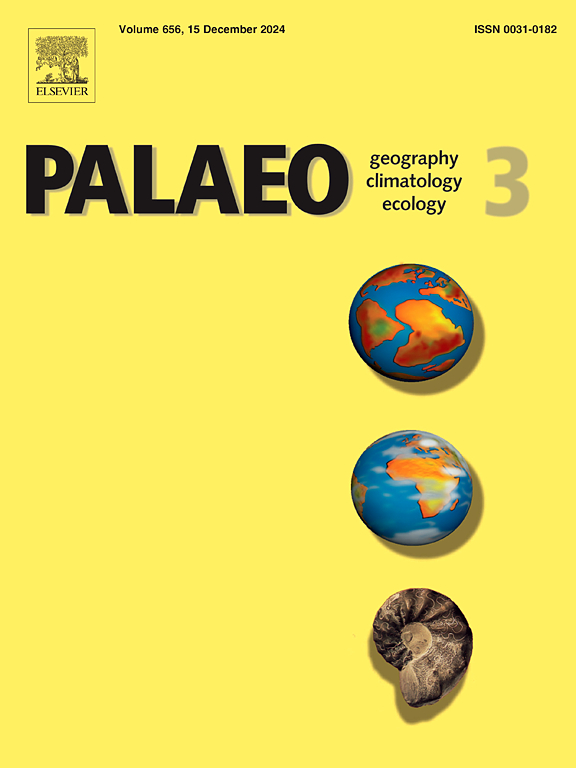Onset of large-scale terrestrial organic carbon burial driven by Early Devonian changes in vascular plants and environments
IF 2.7
2区 地球科学
Q2 GEOGRAPHY, PHYSICAL
Palaeogeography, Palaeoclimatology, Palaeoecology
Pub Date : 2025-05-20
DOI:10.1016/j.palaeo.2025.113039
引用次数: 0
Abstract
The Early Devonian witnessed a major phase in the terrestrialization of land by plants. Understanding the implications for organic matter formation and accumulation during this interval is key to understanding global carbon burial. Existing research on the Early Devonian primarily focuses on marine carbonate records that do not permit evaluation of the mechanisms of terrestrial organic carbon burial, particularly in the early stages of plant colonization. Here, we examine facies associations, environmental evolution, and organic carbon burial within the late Pragian aged Posongchong Formation at the Zhichang section in Wenshan, Yunnan Province, China, a formation previously noted for recording the early radiation of land plants in coastal settings. Sedimentological and geochemical data include: (1) Paleosalinity proxies (B* and B/Ga) and sedimentary structures that indicate fluviolacustrine Facies Association (FA A), tidal flat (FA B), and shallow marine (FA C) facies developed in the study area, with two pulses of deepening separated by shallowing; (2) Total Organic Carbon (TOC) and kerogen maceral analyses that reveal an increase in terrestrial organic carbon content derived from terrestrial higher plants and phytoplankton; and (3) Organic matter preserved in coaly and carbonaceous shales that is mainly derived from continental higher plants that grew in a restricted, stable freshwater-brackish lagoon and floodplain environment. The land plant radiation recorded by the Posongchong Formation occurred within a stable coastal plain that provided a suitable setting for the supply and preservation of organic carbon in this early terrestrial ecosystem, in turn influencing the development of global terrestrial carbon burial.
早泥盆世维管植物和环境变化驱动的大规模陆生有机碳埋藏的开始
早泥盆纪见证了植物陆地化的一个主要阶段。了解这段时间有机质形成和聚集的意义是了解全球碳埋藏的关键。对早泥盆世的现有研究主要集中在海相碳酸盐岩记录上,这些记录不能评价陆相有机碳埋藏机制,特别是在植物殖民的早期阶段。在这里,我们研究了中国云南省文山芝昌剖面的晚Pragian时代波松冲组的相组合、环境演化和有机碳埋藏,该组以前以记录沿海环境中陆地植物的早期辐射而闻名。沉积学和地球化学资料包括:(1)古盐度指标(B*和B/Ga)和沉积构造表明研究区发育河盆相组合(FA A)、潮滩相(FA B)和浅海相(FA C),以浅水为间隔有两个加深脉冲;(2)总有机碳(TOC)和干酪根显微组分分析显示陆生高等植物和浮游植物增加了陆生有机碳含量;(3)煤质和碳质页岩中保存的有机质主要来源于生长在受限、稳定的淡水-半咸淡泻湖和洪泛平原环境中的陆相高等植物。浦松冲组记录的陆地植物辐射发生在稳定的沿海平原,为早期陆地生态系统有机碳的供应和保存提供了适宜的环境,进而影响了全球陆地碳埋藏的发展。
本文章由计算机程序翻译,如有差异,请以英文原文为准。
求助全文
约1分钟内获得全文
求助全文
来源期刊
CiteScore
5.90
自引率
10.00%
发文量
398
审稿时长
3.8 months
期刊介绍:
Palaeogeography, Palaeoclimatology, Palaeoecology is an international medium for the publication of high quality and multidisciplinary, original studies and comprehensive reviews in the field of palaeo-environmental geology. The journal aims at bringing together data with global implications from research in the many different disciplines involved in palaeo-environmental investigations.
By cutting across the boundaries of established sciences, it provides an interdisciplinary forum where issues of general interest can be discussed.

 求助内容:
求助内容: 应助结果提醒方式:
应助结果提醒方式:


